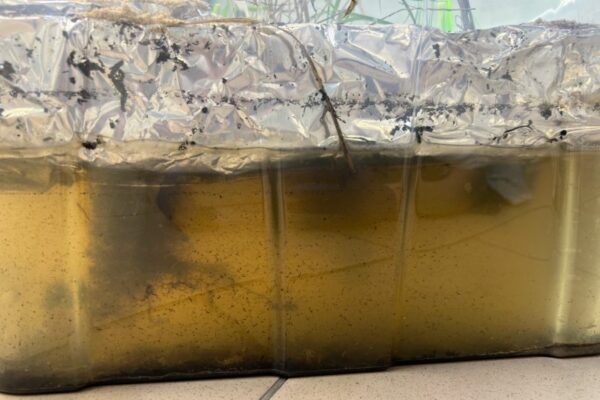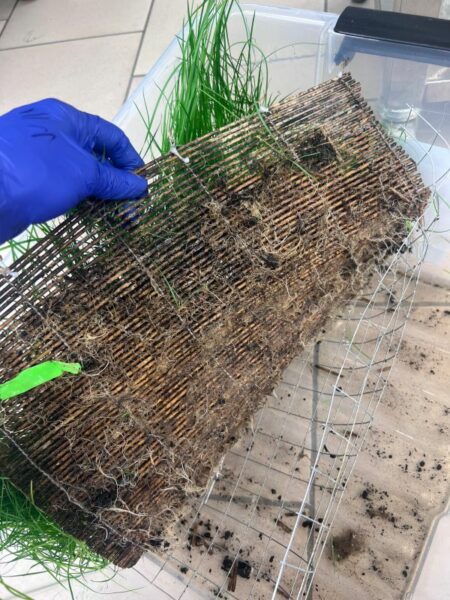RESEARCH EXCELLENCE INITIATIVE
FREEDOM OF RESEARCH – SCIENCE FOR THE FUTURE
“Freedom of Research – Science for the Future” series consists of articles, interviews and short videos presenting research conducted by the winners of the “Freedom of Research” call for proposals
Magdalena Noszczyńska, PhD
Alliance between plants and bacteria in wastewater treatment
| Author: Weronika Cygan-Adamczyk |
Plant rafts blend gracefully into the landscape and, at first glance, do not differ much from other plants growing around a water reservoir. However, this camouflage hides extremely hard-working cleaners, supported in their efforts by microscopic allies. Could this cooperation be an effective way to combat water pollution?
The idea of using living organisms to clean the environment is not new, and further research shows that, depending on the plant species and type of bacteria used, it can be an extremely effective and safe way to neutralise toxic substances that end up in our surroundings. Among those investigating the possibilities of this plant-bacteria alliance is Magdalena Noszczyńska, PhD from the Faculty of Natural Sciences of the University of Silesia, who is carrying out a project entitled ‘Can plants and bacteria work together to remove bisphenols from water?’ as part of the ‘Freedom of Research’ call for proposals (Research Excellence Initiative). Although the analysis of the data obtained is still ongoing, the results are already extremely promising.

Magdalena Noszczyńska, PhD | Andrzej Noszczyński
Individualism or cooperation?
The work carried out as part of the ‘Freedom of Research’ call for proposals was not the first time that the biologist had investigated the impact of plants and bacteria on environmental purification. It had already been proven that common reed and bacteria isolated from its rhizosphere (the space adjacent to the plant’s root system, including the soil and bark cells) can be used to create an efficient system.
“The reeds we obtained at that time were growing in a reservoir in Nowe Chechło. We defined the characteristics of the bacteria that promote plant growth and only then selected the strains suitable for the entire experiment,” says Magdalena Noszczyńska, PhD.
At that time, it was clear that the bacteria had a positive effect on the plants by reducing oxidative stress. However, during the work as part of the ‘Freedom of Research’, it has not yet been possible to confirm such a beneficial relationship. In the latter case, perennial ryegrass growing on land was used in the research, which proved to be an innovative approach. That being said, the data collected shows that this grass proved to be self-sufficient, even though it had exactly the same bacteria to help it as the aforementioned reed. As the biologist explains, both in trials involving ryegrass alone and in those involving bacteria, equally high water purification efficiency was observed, indicating that the plants performed very well on their own.
“We did not see any differences in physiological parameters, where we assessed the level of oxidative stress. However, we still have molecular analyses to perform, so perhaps at this stage we will see some differences,” adds the expert.
This is surprising because bacteria can indeed be powerful allies for plants. Thanks to their ability to produce biosurfactants and to form a thin, sticky biofilm on the surface of roots, they help improve water quality and enable the breakdown of harmful compounds remaining in it. In addition, they can support plant growth by secreting hormones that stimulate the development of the root system.

Study of the cooperation between plants (reeds) and bacteria | Photo by Magdalena Noszczyńska
Persistent cleaners
The aim of the project as part of the ‘Freedom of Research’ call was to check whether plants and bacteria are capable of removing bisphenols from wastewater. These harmful chemical compounds, which have been linked to the development of breast, prostate and thyroid cancer, among others, are widely used in the production of plastics. Raw sewage from the Klimzowiec treatment plant in Chorzów was used for the experiments conducted at the University of Silesia. Magdalena Noszczyńska, PhD created research systems in the form of special mats filled with sifted soil on which ryegrass seeds were sown. Once the plants reached the appropriate height, which took about 3-4 weeks, the experiment began. The system was constantly aerated and supplemented with immobilised bacteria capable of promoting plant growth.
“At the beginning, the root system was small. Observations made at the end of the experiment in the control system also indicated low root system growth. However, where the plants were in contact with sewage, the root system was much larger, which was probably caused by a protective mechanism of the plant trying to reach cleaner areas in the water,” explains the biologist.
As a result of the research, the wastewater was purified to a very high degree. Moreover, a significant decrease in nitrogen as well as chemical and biological oxygen demand was recorded, proving the effectiveness of plants in restoring good water quality. Bisphenols were completely removed. At the same time, it was not possible to prove the involvement of bacteria in the entire process. As mentioned earlier, in this particular case, ryegrass proved to be self-sufficient.
Currently, Magdalena Noszczyńska, PhD and PhD student Julia Borówka are preparing to continue the experiment to see if another type of bacteria might work better as a support for perennial ryegrass. Work is already underway to assess the characteristics that promote plant growth and facilitate the degradation of bisphenols. The researcher received a grant from the National Science Centre (OPUS 25) to create new research systems and analyse them. The project, which she is leading, is called ‘Multifaceted relationships between bacteria and plants during phytoremediation of wastewater co-contaminated with bisphenols F and S’.

One of the research systems in the form of special mats filled with soil on which ryegrass seeds were sown. It allowed the development of the root system to be assessed | Photo by: Magdalena Noszczyńska
Drifting rafts
Until now, the tests have been conducted entirely in laboratory conditions, and the research systems were housed in 30-litre containers in special cultivation rooms. However, the biologist is considering expanding the scale of the experiment and is already referring to solutions based on the use of plants that are already in use in some treatment plants.
“These so-called floating treatment wetlands are systems that have not yet been used on a large scale. They consist of a type of mats with holes cut in them, into which a plant is placed, whose root system removes chemicals,” explains the specialist. She adds that in Poland, water treatment systems based on activated sludge or biological beds are still the ones primarily is use, but these are not suitable for treating water from micro-pollutants, which are currently present in the environment on a large scale and remain highly harmful.
After the experiments conducted at the University of Silesia were completed, the plants used were disposed of, but Magdalena Noszczyńska, PhD explains that the idea is for the species planted in this way to remain in the environment and continue to purify the water naturally. As shown by analyses conducted by researchers from the University of Silesia, there is considerable potential in the use of methods involving plants and bacteria, and further research into better and more efficient species for this process looks extremely promising.
The article ‘Alliance between plants and bacteria in wastewater treatment’ was published in the April issue of USil Magazine No. 7 (327).





